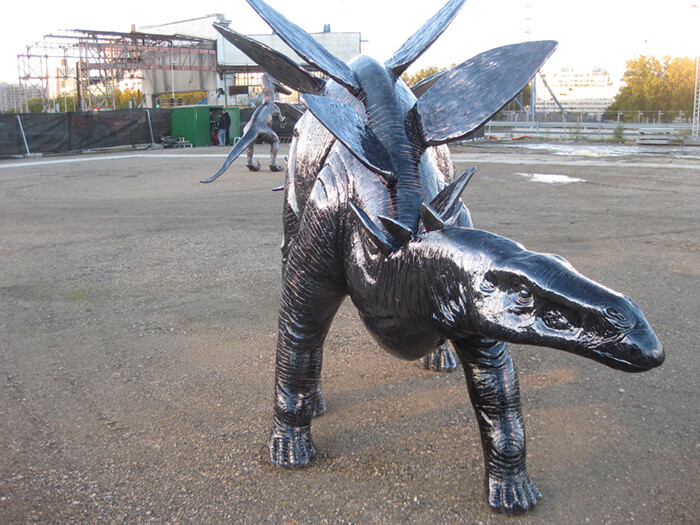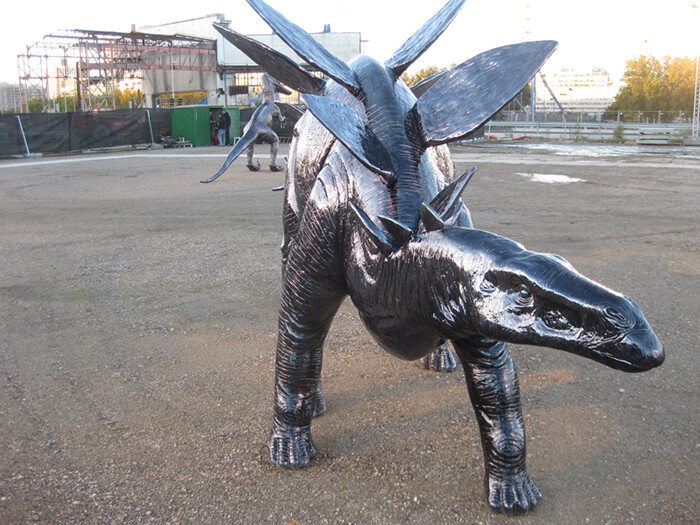It’s hard to pinpoint the moment that FIAC actually started. Extramural events—gallery unveilings, private museum tours, an “immaterial” auction, a magazine launch, a performance on a bateau mouche, and lots and lots of parties—began in earnest on Monday, just one day after Frieze ended, two days before FIAC’s “guest of honor” and press previews, and three full days before the fair’s official opening on Thursday. With so much build up—72 hours of hype fueled by generous amounts of champagne and finger foods—I worried the fair itself would be a letdown.
Early in the week proved a good time to take in the public art on view in Paris and visit a few new venues just outside the city center. Monday evening there was a chic booze-cruise along the Seine to Ile Seguin, a 29-acre island west of Paris. Once home to a Renault factory and pretty much abandoned since the auto plant closed in 1992, a major redevelopment promising exhibition spaces and artists’ studios is underway. R4, the Jean Nouvel-designed arts center, is not scheduled to open until 2015, but in the meantime the project has partnered with FIAC to exhibit outdoor sculpture. As we debarked onto the yet-to-be-gentrified grass-and-gravel atoll, I heard someone exclaim “Welcome to Jurassic Park!” and point to Rob Pruitt’s two fiberglass dinosaurs (2012). Indeed, in its current state, there is a similar feeling of an island experiment gone awry—but in this case it is “plop” art that has run amuck. Fittingly, Annette Messager’s humanoid black nylon windsock (Andrew à Paris, 2012) emulates an advertising technique most often seen at car dealerships. The crowd seemed happy to return to the Paris-bound boat, where we were treated to an amusing in-transit performance by Brooklyn-based artist Shana Moulton who mimed in front of a computer animation projected onto the stern-side cabin wall.
The fact that this year’s FIAC reaches beyond the precious centre ville echoes the current trend of Parisian art institutions, dealers, and artists staking claims outside the city center. Much of the pre-fair chatter, in fact, fixated on two new commercial galleries that have just opened in “greater Paris”: Thaddaeus Ropac’s multi-building campus in a converted factory in Pantin and Larry Gagosian’s renovated hangar at the Le Bourget airport. Both galleries ran shuttles during pre-FIAC and although the spaces themselves and their surrounding neighborhoods (if you can call an airport a neighborhood) are quite different, the fact that two mega post-périphérique showrooms opened simultaneously with similar new large-scale paintings and sculpture by Anselm Kiefer made for ample compare-and-contrast gossip.
Still focused in central Paris, FIAC’s official “Hors les Murs” program (unveiled on Tuesday) has expanded from years past with sculptures, performances, and artists’ films occupying even more public locations on the left and right banks. Two new venues for monumental sculpture are the Place Vendôme (Jaume Plensa) and the Esplanade des Invalides (Jeremy Deller), but the bulk of the installations can still be found in the Tuileries, the Jardin des Plantes, and the Natural History Museum. Some of the outdoor works attempt to engage viewers through interaction (Tadashi Kawamata’s The Exchange Library, 2011) or function (Jeppe Hein’s Modified Social Benches, 2012), but Deller’s inflatable Stonehenge bouncy-castle (Sacrilege, 2012) is hands down (and shoes off!) the most fun.
Conversely, the fair itself is less spread out this year as all of the participating galleries (at 184, up from 168 last year, but down from 195 in 2010) are collected inside the Grand Palais—a feat made possible with the beautiful renovation of the 1200 m2 Salon d’Honneur on the second level. While no one seemed to miss having to pop over to the Cour Carrée at the Louvre (where the up-and-coming galleries have traditionally exhibited), fair-goers and exhibitors alike remarked that despite a unified space, the younger galleries are still ghettoized in the narrow halls upstairs, while the more established galleries rule over the ground-level nave and from the (aptly titled) Salon d’Honneur.
On the main level, under the sky-lit glass and iron roof, art advisors shepherded their clients to blue chip galleries including Marian Goodman, David Zwirner, White Cube, and Lisson, whose offerings were impressive, but no show-stoppers between them. The French galleries had strong presence in the nave. Perrotin brought an unmissable Murakami sculpture (Big Box PKo2, 2011) and Francesco Vezzoli’s high heel-wearing version of Boccioni’s famous Futurist sculpture attracted a lot of attention at Yvon Lambert. Kamel Mennour was talking numbers with a collector interested in a mini tree-house by Kawamata when I passed by.
Many galleries chose to showcase work by artists who currently have museum exhibitions in Paris. Dvir Gallery from Tel Aviv, for example, had a drawing by Adel Abdessemed (Coup de Tête, 2012) and a sieve and bullet construction by Mircea Cantor (Don’t Judge, Filter, Shoot, 2012.) The two artists presently have solo exhibitions right next to each other at the Centre Pompidou.
One of the most understated and refreshingly un-fair-like booths was Ugo Rondinone at Eva Presenhuber. Three cast bronze editions of three different small and seemingly unrelated objects—a pear, a pinecone, and a plaster head—were arranged on the floor in simple, but precise formations. Given Presenhuber’s location near the bustling VIP entrance, the minimalist solo presentation offers a welcome, if fleeting, respite. Another nave highlight was Eigen+Art, where Tim Eitel’s small intimate portraits are paired with large triptych paintings by Marc Desgrandchamps. Eitel’s somber palette and subjects created a nice foil to Desgrandchamps’s bright and airy peopled seascapes.
Why signage art remains so popular at art fairs eludes me, and FIAC certainly did not buck the trend this year. After passing one too many oblique neon phrases—“Someone is getting rich” (Claire Fontaine at Galerie Neu, Berlin) and “It is a world in which something is missing” (Cerith Wyn Evans at White Cube)—and at least three of Jack Pierson’s word sculptures (Cheim & Read, Xavier Hufkens, and Ropac), it was time to head upstairs.
Entering Level 1 at Hall H, the vibe felt immediately different. The craggy exposed brick walls emphasized the generally more humble works the younger galleries in this section are showing. Near the Marcelle Alix booth, where Ian Kiaer’s scavenged window frame fit in perfectly with the unprettified surroundings, I ran into a curator friend who told me she was dreading having to go back downstairs and that she would prefer to stay up here with “her people.” On the whole, the crowd on Level 1 was more youthful and edgier than the crush in the nave. In terms of style and content, Hall H felt more like an open studio event than a major art fair. And I mean this in the best way possible—there is a lot of good art to see there. ProjecteSD from Barcelona, for example, had an eye-catching yellow map painting by Matt Mullican (Paris, naturally), and Jousse Entreprise was not afraid to equate an art fair booth with a home décor boutique, showing Matthew Darbyshire’s installation comprised of colorful and shiny objects displayed on retail-style shelving units.
Making my way back towards the main staircase, I passed a dolly loaded up with champagne bottles in ice buckets on their way upstairs. Realizing that the fair had still not even officially opened yet, I experienced a sympathy wave of preemptive exhaustion for the gallerists who would be on duty until Sunday. But, in short, FIAC 2012 did not disappoint. And from the critics, collectors, and exhibitors I spoke to who had just come from Frieze—hearty souls!—Paris, it seems, hosted the better fall fair this year.













